Nurseries drive biodiversity in arid climates
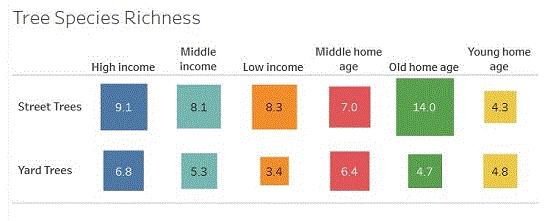
Average number of tree species found in different neighborhoods in the Salt Lake Valley.
If you’re going to invest water resources on trees in arid climates, make it count. First, you’ve got to understand what’s driving the current assemblage of plants in cities. There’s new language to label the results: “Luxury Effect” and “Ecology of Prestige.”
Nurseries, acting in concert with (or as a feedback loop to) consumer demand/preferences, determine much of the biodiversity in residential landscapes, especially in arid climates. Based on a study of neighborhoods in the Salt Lake Valley of Utah, researchers found that tree species diversity is shaped by the species available in nurseries, preferences of the homeowners and even the tree selections of their neighbors.
“For urban trees, the attributes that are desirable to these decision makers [homeowners, landscape architects, urban foresters, city planners, etc.] may not match plant functional traits typically used in ecological research. For example, residents purchasing trees for their yard are likely not as concerned with seed mass as they are with shading potential,” write the authors of “Biodiverse cities: the nursery industry, homeowners, and neighborhood differences drive urban tree composition” in the current issue of Ecological Monographs.
Like many arid western climates, trees in public and private spaces are planted by residents. Few trees inventoried in the Salt Lake Valley study are native to the valley. In eastern climates, most trees, even in cities, occur naturally.
The researchers noted that yards and neighborhoods close to each other had more similar species patterns, suggesting that neighborhoods have distinctive landscape identities.
“These landscape identities likely contribute to the role that trees have in creating a sense of place,” the team writes. “Whereby people form a bond with specific trees and with the attributes of a place that trees help create."
Here’s some new language to help term biodiversity differences in private landscapes: “Luxury Effect” and “Ecology of Prestige.” The Luxury Effect is created when wealthier residents shop at local nurseries where plants are more expensive (about $100/tree in this study) and there’s a greater/more diverse assortment of species available to purchase. "Ecology of prestige" is then created when residents of the wealthier neighborhoods plant a greater, more diverse assortment with traits and attributes that help to create a sense of place in that neighborhood.
Urban ecology brings social science into ecology and is relatively new, Dr. Diane Pataki, University of Utah, says. “The role of nurseries is largely absent from the ecological literature," she adds.
Diane says that the imported tree diversity is a benefit to the Salt Lake Valley. “I’m skeptical of the idea that the best way to achieve sustainability goals in urban landscaping is by planting native species,” she says. “That’s way too narrow of an approach. The urban forest is quite diverse and more diverse than the trees that were here before. In fact, the native landscape was almost treeless and that’s not what most people want for the city.”
A few factoids from the study:
-
148 distinct species were present in neighborhoods and 262 species were offered for sale in nurseries, 11% of trees in neighborhoods were native, 9% of trees offered for sale were native
-
Locally owned nurseries offered nearly three times as many species (219), as national mass merchandisers (80). There was strong correlation between the “abundance of each species in streets and yards and the abundance of each species found in the stores.”
-
Older neighborhoods had more diversity among street trees than younger neighborhoods, while higher-income neighborhoods had more diversity and more trees overall than lower-income areas. “Overall tree beauty was higher in younger neighborhoods compared with middle-aged and older neighborhoods.”
-
Higher income residents were more likely to shop at local nurseries, but “all residents shopped at an equal number of national chain stores.”
-
Shading and beauty were the most important tree services in neighborhood surveys, while water use, root damage (sidewalks) and shedding debris were most important disservices. When selecting a tree to plant, height, maintenance and shading were most important.
-
83% of residents surveyed had a favorite tree in their yard (Acer was most often the favorite).
Cities that seek to increase resilience and sustainability may seek to change landscape preferences and behavior. The authors caution cities not to ignore what residents think and prefer about the plants they purchase and how available plants are through the nursery trade. Ecologists, they say, can play a role by bridging the information gap between plant traits that meet cultural and regulating ecosystems services. Translation: Functional landscapes and functional plants can look good too.
—Excerpted in part from Nursery stock, homeowner preferences drive tree diversity in Salt Lake Valley by Paul Gabrielson for the University of Utah.
Biodiverse cities: the nursery industry, homeowners, and neighborhood differences drive urban tree composition by M. L .Avolio, D. E. Pataki, T. L. E. Trammell and J .Endter-Wada in Ecological Monographs.
_______________________________________________________________________________________

"Native Gardens" isn’t on Broadway, but it may be coming to a city near you
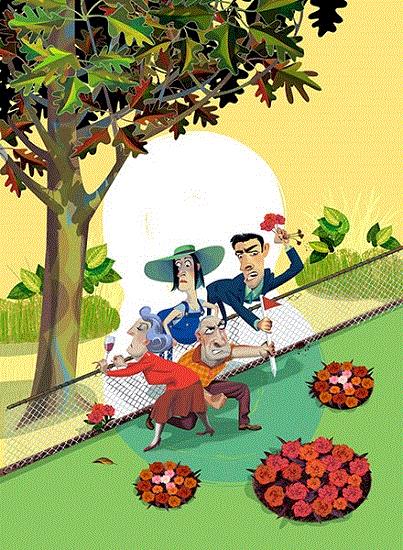
"Native Gardens" poster by Nigel Buchanan for the Washington, D.C. play.
So the play "Native Gardens" by Karen Zacarias hasn’t hit Broadway yet, but it is making the rounds in cities around the country. The story is about a young, attractive power couple expecting a child, Pablo and Tania, who buy a house in a historic neighborhood next to Virginia and Frank and their prized English garden. The couples become entangled in a dispute about their property line. On one side of the hedgerow, the hip and trendy Pablo and Tania and their native plants approach and the other, the older, distinguished and respected Virginia and Frank, with a manicured, horticultural masterpiece.
Among the cities where you can catch "Native Gardens" are Denver (Center for the Performing Arts Theatre Company) (Spring 2018); Providence, Rhode Island, Trinity Repertory Company (Spring 2018); and San Diego, The Old Globe in San Diego (Summer 2018). "Native Gardens" has already played Cincinnati, Minneapolis, Orlando and Washington, D.C.
_____________________________________________________________

National Landscape Career Day launch

The National Association of Landscape Professionals has created Landscape Career Day, a nationwide initiative to be offered locally to spotlight the hundreds of thousands of jobs that exist in the landscape industry.
Industry companies are encouraged to host events at their company and within their communities that showcase industry careers and highlight professional paths for potential employees. NALP’s Industry Growth Initiative has created a 21-page toolkit, available to everyone on LandscapeIndustryCareers.org.
“We need to change people’s impressions of the profession by helping them touch and feel the important and rewarding work done by the talented men and women who help families, communities and the environment each and every day,” noted Missy Henriksen, NALP’s vice president of public affairs.
________________________________________________________________
U.S. cities can save billions with green, smart surfaces
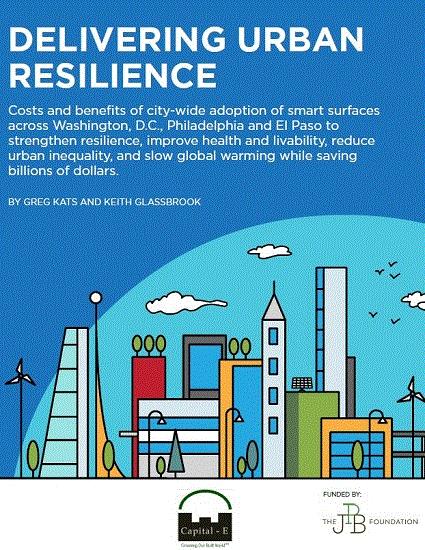
Functional landscapes—from green roofs, urban forests and permeable pavement—create resilience. "Delivering Urban Resilience"—authored by Capital E in conjunction with 15 non-profits, NGOs and municipalities—features writers Greg Kats and Keith Glassbrook quantifying the benefits of “smart surfaces” that manage the sun and rain for three cities: El Paso, Philadelphia and Washington, D.C.
"Delivering Urban Resilience" provided support for investment in smart surface technologies, stating they would result in net present values of $1.8 billion in Washington, D.C., $3.6 billion in Philadelphia and $540 million in El Paso over 40 years. Benefits are largest in low-income areas.
“Lack of understanding of the costs and benefits of smart-surface technology and policy options has severely limited city policies,” the report states. The 305-page document helps to bridge the gap with detail on assumptions and calculations and the citations to justify them.
Also see: A financial case for green roofs, solar panels, and permeable pavement by Patrick Sisson on Curbed and Green Design Isn’t Just a Luxury. It Could Save Cities Billions by Cooper Martin on CitiesSpeak.
______________________________________________________________

March 21: Forests & Sustainable Cities
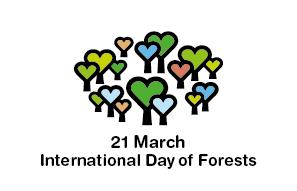
The United Nations’ Food & Agriculture Organization will spotlight "Forests and Sustainable Cities" as the theme of their International Day of Forests on March 21, 2018.
______________________________________________________________
7 EU nursery orgs join forces to push green cities
Seven nursery organizations that are part of the European Nurserystock Association (ENA) have launched the “Green Cities for a Sustainable Europe” promotion campaign in Belgium, Bulgaria, Denmark, Germany, France, the United Kingdom and the Netherlands.
Funded mostly by $2.6 million (€2.1 million) in EU Commission grant funds, the campaign is to run through 2020.
The campaign is targeted to influencers and deciders to raise the awareness and understanding of the benefits of live plants in urban spaces for citizens and the environment. "Green Cities for a Sustainable Europe" is to include congresses, seminars and business meetings, as well as PR and a website.
ENA members working together and providing partial matching funds include AVBS-VLAM (Belgium), BAOPN (Bulgaria), Danske Planteskoler (Denmark), BdB (Germany), Val’hor (France), HTA (UK) and Anthos-LTO-‘De Groene Stad’ (the Netherlands). The team met during IPM in Essen (Germany) to finalize details and plan 2018 activities.
Members of the associations involved in Green Cities for a Sustainable Europe say that the scientific evidence base showing the benefits of live plants to public health, climate modulation and air quality is growing. The cooperative initiative will bring that information to key policy makers and influencers who can put it to work to benefit cities. At the same time, they’ll be promoting plants in ways the industry has only just begun to pursue.
____________________________________________________________
Top 10 LEED states in 2017
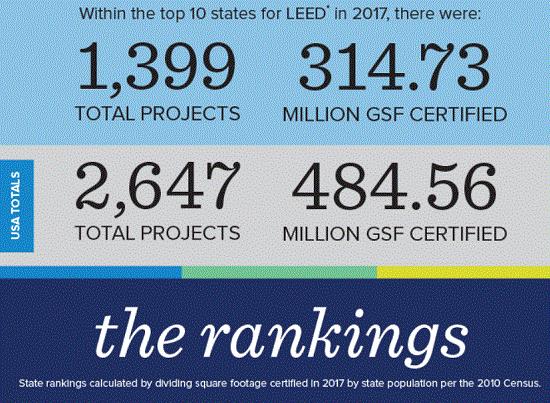
The U.S. Green Building Council announced the top 10 states for most LEED certified square footage. They are: Massachusetts, New York, Illinois, Hawaii, Maryland, Minnesota, Georgia, California, Virginia and Colorado. The District of Columbia is not included (but would have ranked) because it's not a state.
Collectively, 1,399 commercial and institutional projects achieved LEED certification within the Top 10 States in 2017, representing 314.7 million sq. ft. of real estate. Nationwide, 2,647 commercial and institutional projects achieved LEED certification in 2017, representing 484.6 million sq. ft. of real estate.
In 2015, Green Business Certification Inc. (GBCI) acquired the landscape complement to LEED, the Sustainable SITES rating system. They began administering certification as part of a strategy to ensure that the sustainability movement addresses all areas of the built environment. GBCI now awards all the Sustainable Sites (SS) credits in LEED v4 BD+C for a project that achieves SITES Gold certification or higher.
More than 40,000 commercial and institutional projects representing more than 6.5 billion sq.ft. of space have been LEED-certified to date worldwide, with another 51,000 projects representing 13 billion sq. ft. in the pipeline for certification.
_______________________________________________________________
New Turf Varieties for Low Water
Reader comment


“Thank you, Debbie! I appreciate your willingness to share my work with your readers. I actually receive NewTerrain and have my students read your articles throughout the year. I attached something else you may find interesting from the study: Page 2 has student top three rankings (see graphics). Have a great afternoon!”
—Jim Hansel M.En; CASE Certified ASP; ONLA Certified Landscape Technician; TTW; Sustainable Urban Agriculture Instructor, Diamond Oaks Career Development Campus
_______________________________________________________________
Events
February 21-22: Urban Green Infrastructure Summit (WA)
The Western Center for Metropolitan Extension & Research at Washington State University is conducting an Urban Green Infrastructure Summit at the Embassy Suites in Tigard, Oregon, on February 21 and 22. This summit will connect government and agency personnel, university researchers and extension professionals to create new collaborative networks, identify research and education priorities, and share existing resources.
February 22-23: 2018 Land & Water Summit (NM)
The Ripple Effect: Stormwater & Tree Canopy is the theme for the 2018 Land & Water Summit sponsored by the Xeriscape Council of New Mexico to be held in Albuquerque, New Mexico, at the Albuquerque Airport Sheraton. The opening keynote, “Climate Resilience: A new paradigm of change,” will be delivered by Mike McMahon, HDR Engineering.
February 23 Green Matters: Restoring Our Urban Landscapes (MD)
How can we design our landscapes in ways that prevent harm to existing ecosystems and regenerate the environment? Join Green Matters, an annual symposium sponsored by Brookside Gardens, that concentrates attention on the intersection of horticulture and environmental issues. This year’s event, Restoring Our Urban Landscapes, will be held at the Silver Spring Civic Building in Silver Spring. Talks are to include: "Biophillic Urbanism: A New Approach for Creating Sustainable Environments" by Dr. Timothy Beatley and Teresa Heinz, University of Virginia; "Creating Healthy Soils Through Regenerative Gardening Practices" by Jeff Lowenfels, author and columnist; "Habitat Matters: Restoring Ecosystem Functionality & Biodiversity" by Heather Holm, horticulturist, biologist, writer and landscape designer; and "Lessons In Landscape Design: Integrating Natural Systems into the Built Environment" by Kate Hayes, Associate, SCAPE Landscape Architecture DPC.
February 28: Soak Up the Rain New England Webinar
The Guiteras Green Infrastructure Community School Project will be presented February 28 from 2:00-3:30 p.m. EST. This U.S. EPA webinar will highlight a successful green infrastructure project at the Guiteras School in Bristol, Rhode Island. From landscape design to community and student engagement, the project treated and infiltrated stormwater runoff from the entire school, reduced impervious surfaces, controlled a growing Canada goose population and engaged 300 students at the school with hands-on projects.
March 1: Building Resilient Communities Webinar
Presenters of Building Resilient Communities will focus on two proof-of-concept projects co-sponsored by the U.S. Environmental Protection Agency (EPA) and the Federal Emergency Management Agency (FEMA), in which two communities enhanced their resiliency by integrating green infrastructure elements of their stormwater and watershed plans into their hazard mitigation plans to achieve co-benefits, such as improving water quality and preserving resources. Presentations include “Green Infrastructure for Drought Resilience” (Massachusetts) and “Nature-Based Solutions to Hazard Mitigation Planning” (Oregon).
March 2-3: Ithaca Native Landscape Symposium (NY)
Learn about native plants in the wild and their roles in sustainable landscapes at the 10th annual Ithaca Native Landscape Symposium at the Cinemapolis Theater in Ithaca, New York. The topics to be covered include: “Native Plant Responses to Climate Change in Cornell’s Mundy Wildflower Garden: Thirty Years of Data!”; “Planting in a Post-Wild World;” “Designing Dynamic Native Landscapes;” “Maintaining Dynamic Native Landscapes;” and “Rain Gardens and Shoreline Buffers,” among others.
March 7-8: 24th Annual ELA Conference& Eco-Marketplace (MA)
Join the Ecological Landscape Alliance for their two-day Conference & Eco-Marketplace in Amherst, Massachusetts. Wednesday, March 7 will have two concurrent day-long sessions focusing on "Designing for Carbon Sequestration and Ecological Methods of Maximizing Landscape Productivity and Potential." The day will conclude with dinner and a keynote address, "Landscape Design as Ecological Art," by landscape architect Darrel Morrison, FASLA. Thursday, March 8 includes concurrent workshops covering a variety of topics, including restoring urban habitat, permaculture approaches to managing invasive species and designing with the wild in mind. The day will also include two panel discussions, a talk and demonstration on seeding and propagating native plants, and a tour of the landscape for the UMass Design Building, recently constructed and considered a model of ecological design.
March 16: Greening Urban Childhood by Design (NC)
The 11th Annual Growing in Place Symposium, Greening Urban Childhood by Design, will be held at the North Carolina Museum of Natural Sciences in Raleigh. The theme, "Urban Nature by Design," will cover topics such as “Applying biophilic design to restore biodiversity to cities;” “Planning urban green/blue infrastructure to engage children and families;” “Managing urban habitats to maximize play and learning opportunities;” and “Ensuring culturally equitable nature experiences.” The event is geared to public/private sector practitioners, landscape architects, architects, planners, parks and recreation professionals, teachers and environmental educators, and elected officials.
April 14: Grow Native! Plants with a Purpose (MO)
Grow Native! Plants with a Purpose: Native Plants in Gardens and Landscapes, Maryville, will feature Dave Tylka, Dr. Ed Spevak from the Saint Louis Zoo, Doug Peterson on soil health, Steve Buback on trees and shrubs, Scott Vogt on garden and landscape design, installation and maintenance, and Ruth Farrand-Cox on native edibles.
_________________________________________________________________
Worth reading
Best,

Debbie Hamrick
NewTerrain
This email was received by 18,681 readers.
If you're interested in advertising in NewTerrain, contact Kim Brown.